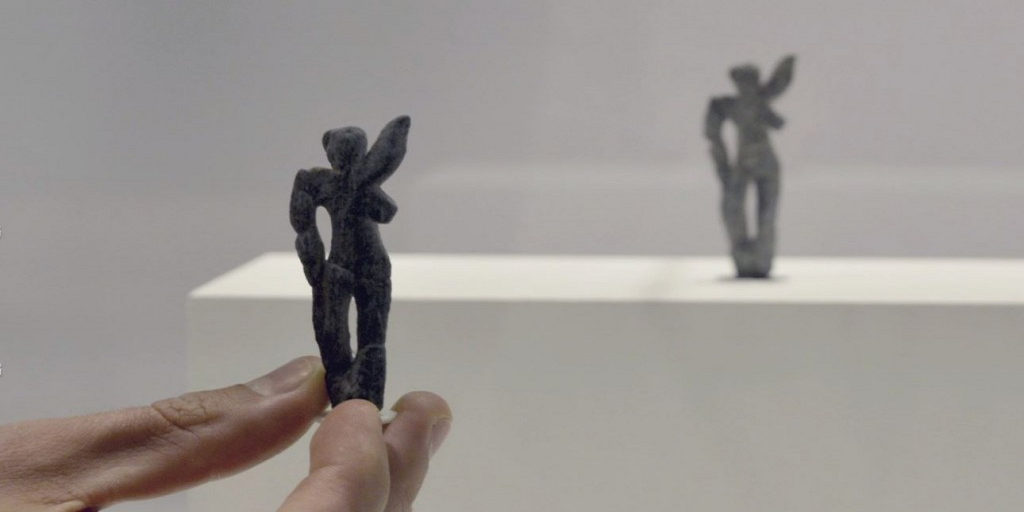As part of a joint exhibition between the Royal Museum of Fine Arts of Belgium and the Louvre Museum, Fuel3D retailer Trideus 3D scanned and printed the 30,000-year-old Venus of Galgenberg figurine. The exhibition that is currently running in the Brussels museum is called 2050 – A Brief History of the Future and will include over seventy contemporary pieces of artwork that will look forward to the year 2050 and will address social issues like over-consumption, global conflicts, scarcity of natural resources and social and economic inequality. The museum wanted to include a modern recreation of the Venus of Galgenberg by having the ancient figure 3D scanned and then duplicated using a state-of-the-art 3D printer.
The Venus of Galgenberg was discovered back in 1988 during an excavation of a fossilized dwelling belonging to Palaeolithic hunters found in Galgenberg, Austria. The tiny figurine was broken into several pieces but was clearly identifiable as a carved figure of what appeared to be a woman dancing. Weighing only 10 grams, the Venus is made of amphibolite slate with a dusky green coloring and her body is turned slightly to the side with her arm extended in the air. The Venus is mostly three-dimensional with the back being intentionally left flat so she could easily be laid down face-up. While they have no real evidence, based on historian speculation the figurine most likely had a cultic or religious significance.
In order to accurately recreate the Venus of Galgenberg the museum turned to a local 3D printing services company called Trideus. The tiny figurine was scanned at its regular home located in Vienna using the Fuel3D SCANIFY 3D scanner. The SCANIFY is a handheld, point-and-shoot 3D scanner capable of capturing high-resolution, full-color 3D models of objects in less than 0.1 seconds. The raw scan data was stitched together using Fuel3D Studio, a powerful software package developed specifically for the Scanify device. The result was a highly detailed recreation of the Venus that duplicates every crack, chip and variance in color on the original. And considering that the Venus of Galgenberg is only 2.8 inches (7.2 cm) tall the level of detail captured was pretty spectacular.
“This was a wonderful project to be part of. We developed SCANIFY to help bring the potential of 3D to a wider audience and this application is a perfect example of how it is doing that,” said CEO of Fuel3D Stuart Mead.
You can see a 3D render of the Venus of Galgenberg here:
Once the Trideus team had the complete 3D model of the Venus they decided to print her in sandstone using a gypsum-based powder 3D printer. The printer lays a thin layer of powder down on the bed and the model will be printed layer by subsequent layer using a combination of a binding material and colored ink. Once the print is complete, a high-powered air syringe is used to blast away any excess material and the model will be submerged in a hardening material not unlike super glue.
You can see the entire process of recreating the Venus of Galgenberg here in a great video made by Fuel3D:
“We are delighted with this part of our exhibition, which truly shows the potential of technologies like 3D printing and scanning. It has been a pleasure to work with Fuel3D and Trideus on this project. With this, we hope to initiate a reflection and to open a debate on the evolution of the museum in the digital era,” said the curator of the 2050: A Brief History of the Future exhibit and of the Royal Museum of Fine Arts of Belgium, Jennifer Beauloye.
The Venus of Galgenberg is dated to be about 30,000 years old and is considered one of the oldest figurines that has ever been discovered. She is displayed permanently by the country that discovered her at the Museum of Natural History in Vienna, Austria. Curators at the Royal Museum of Fine Arts of Belgium chose the Venus as the ancient artwork that they wanted to recreate specifically because of her age. The intent was to demonstrate one of the ways that technology might change the way that the public will experience ancient art and fossils in the future.
Let us know your thoughts on the use of 3D scanning and printing in the 30,000 Year Old Figurine Forum thread on 3DPB.com.

